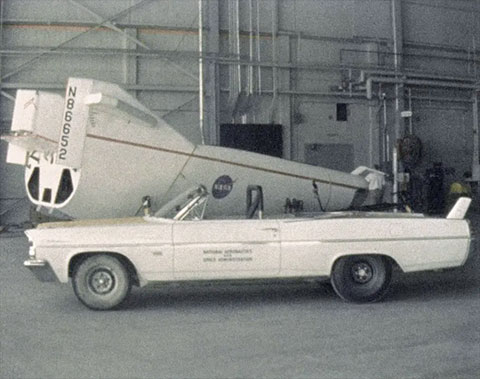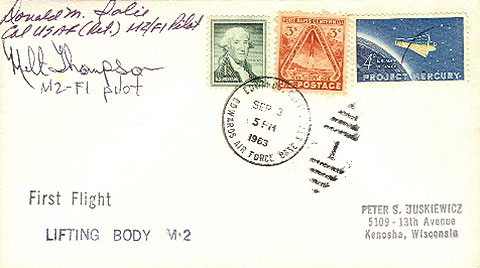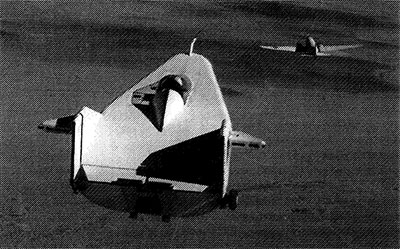|
|

|
|
Author
|
Topic: Space Cover 134: Lifting Body and Hot Rod
|
stevedd841
Member Posts: 299
From: Millersville, Maryland
Registered: Jul 2004
|
 posted 11-06-2011 09:38 AM
posted 11-06-2011 09:38 AM
   
Space Cover of the Week, Week 134 (November 6, 2011) Above: The NASA Pontiac Catalina customized hot rod convertible and lifting body tow car is pictured in front of the M2-F1 lifting body wingless experimental aircraft after completion of an early Pontiac towed test. The in-house NASA project was completed for the bargain price of $30,000, with the Pontiac hot rod included, photo credit NASA Dryden Flight Research Center, California.  Above: Test pilot Milt Thompson has signed this test cover, September 3, 1963, commemorating his M2-F1 lifting body test flight near Edwards Air Force Base, California. A total of 400 car-towed flights were made by the M2-F1 lifting body with 77 flights being towed by a U.S. Air Force C-47 aircraft. This early M2-F1 lifting body flight cover signed by Milt Thompson is shown with thanks to Dennis Dillman and is from his cover collection. Space Cover #134, The Lifting Body Aircraft and the Hot Rod It truly was a homemade effort. With extremely little in the way of resources and staff, a small group of scientists, engineers, and staff members at the NASA Dryden Flight Research Center, California, wanted to build an experimental aircraft. One person was a "hot rod" enthusiast, another a sail plane buff, and a few others were airplane aficionados. This small group wanted to further test the startling work of NASA engineer Dale Reed concerning wingless "lifting bodies" in which a flight vehicle could fly without wings, relying solely on its aerodynamic property of lift being greater than drag. But, an experimental aircraft with no wings? This was a startling concept indeed! And, further, it was regarded as a bathtub on a tricycle by the test pilots who were observing this effort. Reed convinced his center director, Paul Bikle, that the lifting body concept was worth further research and received discretionary funding, approximately $30,000, to build the M2-F1 lifting body (meaning, manned two, flight 1), in a cordoned-off section of a hangar at the NASA Dryden Flight Research Center, with a sign reading "Wright's Bicycle Shop" on the curtain shrouding the area. As the lifting body would be unpowered, center employee Whitey Whiteside, also a local hot rod racer, aided the team by facilitating acquisition of a new 1963 Pontiac Catalina convertible. He oversaw the customizing work on the NASA Pontiac at two local car racing shops for the tow car to have the capability of driving and sustaining 110 mph with the M2-F1 lifting body experimental aircraft being pulled behind the car. Gus Briegleb, a high performance sailplane builder at nearby El Mirage Airport, a forty-minute drive from the NASA's Dryden Flight Research Center, was enlisted to build the aircraft fuselage out of wood and plywood. The souped-up Pontiac Catalina convertible outfitted as a tow vehicle and a new, pristine M2-F1 vehicle were in position on dry lake the morning of March 1, 1963, with NASA pilot Milt Thompson in the aircraft cockpit and ready to go. The M2-F1 vehicle bounced down the dry lake behind the Pontiac but was unable to gain enough lift to achieve liftoff. In putting the M2-F1 back through wind tunnel tests at Ames, the vehicle's control system was identified as the problem and was subsequently modified. A second opportunity to fly the M2-F1 occurred April 5, 1963. This time, Milt Thompson lifted off behind the Pontiac and stayed aloft as the Ponticac sped across the dry lake for the test. In the course of the day, several test flights were made by Thompson and towards the end of the day he was able to fly the length of the four-mile test area while under tow. With additional experience in subsequent months, Thompson was able to make additional M2-F1 towed flights with increased speed and higher altitudes. Tragedy was narrowly averted on take-off on Jerry Gentry's M2-F1 test flight July 26, 1965, behind "Gooney Bird," the USAF C-47 tow plane piloted by Stan Butchart at Edwards Air Force Base, California. Climbing past 200 feet altitude, the M2-F1 aircraft began oscillating wildly. Co-pilot of the C-47 tow plane, Vic Horton, watched in horror as the M2-F1 with Jerry Gentry rolled belly-up and disappeared from view behind the tail of the tow plane. Butchart yelled, "Release" and then "Eject" to Gentry, but the test pilot had his hands full trying to correct the low amplitude lateral oscillation that confronted him with the experimental aircraft. Probability of recovery from an inverted and nose high condition by a pilot would be zero. Gentry trying to deal with the situation, ignored the probability of crashing and upon his release from the tow aircraft, deftly completed the M2-F1's barrel roll touching down hard on the dry lake's landing surface at the bottom of the barrel roll as if it were planned. His in-flight emergency had transpired in only nine seconds from beginning to end, and had smashed the M2-F1's landing gear. Gentry calmly exited the M2-F1 and walked away with no personal injury or other apparent aircraft damage besides a collapsed Cessna 150 landing gear. In aviator terminology, he thought as he walked away, "Any landing you walk away from is a good one!" Some landing! NASA engineer, Dale Reed, a strong proponent of lifting body theory at the NASA Flight Research Center and also involved in M2-F1 development and testing, later accurately described lifting body flight and its importance in this period. "...the lifting-body concept was so tentative in the minds of space planners that the M2-F1 program seemed destined to have pronounced effect on the direction taken afterwards in space vehicles, the potential for development of horizontal-landing spacecraft fairly much dependent upon our success." Reed further commented that if there had been a serious accident with the M2-F1, the program would have been finished with no additional lifting body flights being made and impacting on horizontally landing spacecraft including planning for the Space Shuttle. Summarizing these points, Reed remarked, "...the M2-F1 program could be an adventure in success and open the door for future lifting-body programs." And, that is exactly what happened! Steve Durst, SU 4379 |
bobslittlebro
Member Posts: 257
From: Douglasville, Ga U.S.A.
Registered: Nov 2009
|
 posted 11-06-2011 02:07 PM
posted 11-06-2011 02:07 PM
   
One of my favorite subjects! |
micropooz
Member Posts: 1752
From: Washington, DC, USA
Registered: Apr 2003
|
 posted 11-06-2011 03:28 PM
posted 11-06-2011 03:28 PM
   
Great writeup, Steve! Especially on Gentry's pilot-induced-oscillation on his checkout flight!To add to that story, that was his FIRST pilot-induced-oscillation. On August 16, 1966 he made his second attempt at a checkout flight, and lo-and-behold, the exact same sequence played out again! After this second time around, the folks at Dryden decided to end the M2-F1 flights and concentrate on the heavier-weight lifting bodies that had just started into flight test at that time. It was later found that the cause of Gentry's oscillations was the fact that he was very short in stature, and when the M2-F1 was nose-high during takeoff, he couldn't see the horizon or the towplane over the dashboard of the M2-F1, making it impossible to control the attitude. Gentry went on to a very successful career testing the heavyweight lifting bodies and later a combat tour in Viet Nam. Here is a cover hand-cancelled at Edwards, CA on August 16, 1966 for Jerry Gentry's second M2-F1 flight, autographed by Gentry.  |
stevedd841
Member Posts: 299
From: Millersville, Maryland
Registered: Jul 2004
|
 posted 11-07-2011 02:44 PM
posted 11-07-2011 02:44 PM
   
Great pilot signed cover above, Dennis, many thanks! I had forgotten about Jerry Gentry's second "barrel roll" landing August 16, 1966, over Edwards Air Force Base, California, and his inadvertent second iteration of this hair raising landing. Thank you also, Tim, for your comments about my space cover of the week for the first Pontiac hot rod assisted tow of a lifting body experimental aircraft, too. Thought you also might want to see this photo towards the end of the tests with the M2-F1 and before the advent of the heavier and more aerodynamic lifting body experimental aircraft.  Above: USAF C-47 (call sign) "Gooney Bird" tow aircraft in upper right of this photo with the plywood M2-F1 experimental lifting body aircraft in the foreground under tow, over Dry Lake, Edwards Air Force Base California. The C-47 provided 77 aircraft tows for the M2-F1 lifting body providing it with a stabler operational flight, higher aircraft altitude, and higher airspeed. Note in the photo that the M2-F1 is higher and to the left of the C-47 to minimize air turbulence in the wake of the towing aircraft. |
Bob M
Member Posts: 1893
From: Atlanta-area, GA USA
Registered: Aug 2000
|
 posted 11-08-2011 11:43 AM
posted 11-08-2011 11:43 AM
   
Steve and Dennis, Great covers, photos and a fascinating story. Hopefully, some non-space cover collectors will venture down here to the Stamps and Covers forum to see and enjoy all this. | |
Contact Us | The Source for Space History & Artifacts
Copyright 1999-2024 collectSPACE. All rights reserved.

Ultimate Bulletin Board 5.47a
|
|

|
 advertisement advertisement

|















